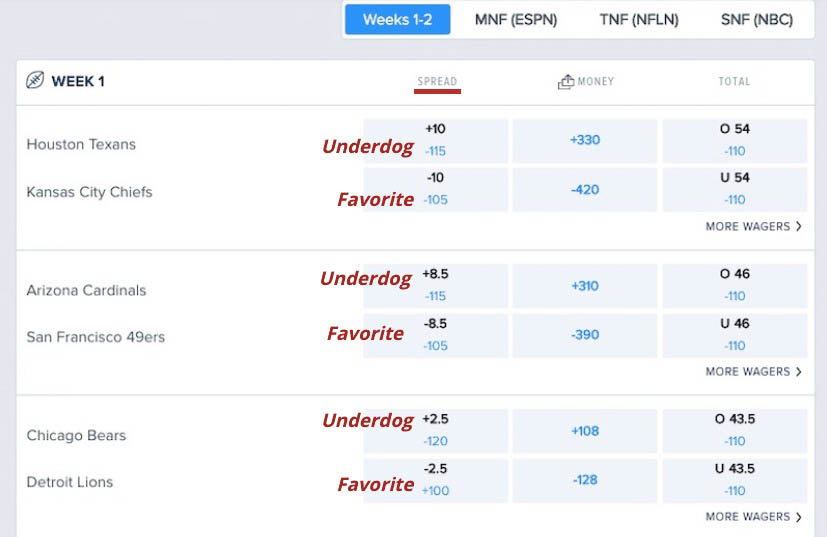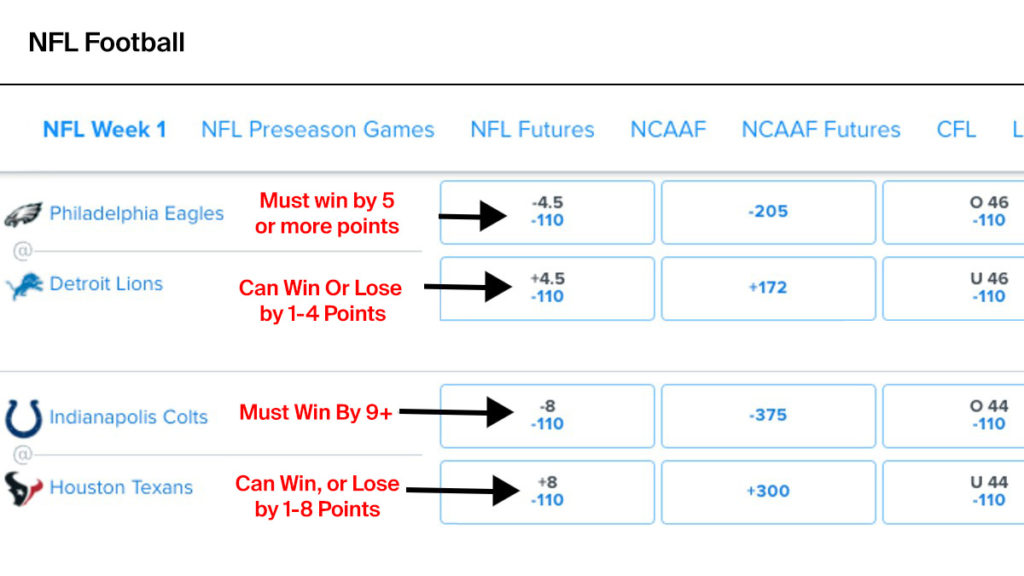Sports betting is fun, especially when you’re winning. But, when you’re betting on the many types of sports, what should you know? What are the basics that will help you win? Read on to learn our tips on how to bet on sports if you’re a beginner so you can win!
1.) Know The Difference Between Favorites vs. Underdogs
When oddsmakers release a betting line on a game, the very first thing they do is determine which team is the favorite to win and which is the underdog (less chance of winning). If you’re the favorite, you’re more likely to win the game and you’ll see on the chart that this team will get a minus sign next to its odds. The underdog is expected to lose and gets a plus sign. Here’s an example of how one would look

2) Learn About “The Spread”
The “spread” is the difference between the two teams in play in terms of their expected points to be scored in the game. This allows bettors to make bets on how close a game will be, as opposed to simply betting on the winner and loser. The greater the spread, the bigger the underdog.

In the example above, The Eagles are a -4.5 favorite over the Lions in Week 1. So, anyone betting on Philadelphia would need the Eagles to win by 5 or more points. Anyone betting on Detroit needs the Lions to lose by 1-4 points or win the game.
- Eagles win by 7: Eagles bettors win
- Eagles win by 3: Lions bettors win
- Lions win by 3: Lions bettors win
Point spreads are adjusted for team ability and many other factors. That’s why the Colts are an 8-point favorite on the road against the lowly Texans, while the Eagles are a smaller favorite on the road against the Lions.
Spreads are available in every sport but most common in higher-scoring sports like basketball and football.

You’ll notice that both spreads are listed in front of a minus number (-110). That number is simply to denote the tax taken by the sportsbook. Regardless of which spread you choose to take, you’ll have to risk $110 to win $100 (or $11 to win $10, etc.).
In certain cases, though, the teams will be seen as even matches, and the spread will be zero points (called a pick’em). In games like these,, assuming the tax is once again -110 on each side, there is no underdog. If one team’s tax was lower, however (-105 vs. -115, for example), that team would be considered a very slight underdog, as that would mean it would take a $105 bet to win $100, as opposed to a $115 risk for the other side.
3.) Moneylines
The second way to bet on a favorite or an underdog is on the moneyline. A moneyline bet requires you to just pick the winner of the game, and uses American odds to calculate the payout. Odds are centered around winning $100
Example: If you’re betting a -200 favorite, you need to risk $200 to win $100 or a fraction of that if you bet less than $100. For example, betting $20 will win $10 or betting $2 to win $1.

In the example above, Oddsmakers believe Indianapolis is the much stronger team and favored to win. So if you bet the Colts just to win the game, you need to risk a larger amount.
The Colts are -375 which means you need to bet $375 to win $100 or $37.50 to win $10.
The Texans are +300. So, if you make a bet of $100, you’ll win $300. Or if you bet $5, you’ll win $15.
4.) Props
These days, betting has developed and betting spreads and totals isn’t enough for most people anymore.
Props, short for proposition bets are any wager that is not a standard point spread, moneyline or total bet.
Some examples include:
- Lebron James over or under 5.5 assists
- Joc Pederson over or under 6.5 strikeouts
Like point spreads, most of the time, you’ll need to pay the price with props. In the example, Pederson’s strikeout total against the competitor is set at 6.5. But it’s more likely than not he goes under, according to these lines, so you have to pay a steeper price to bet the under than the over.
5.) Parlays
A parlay is a type of wager where two or more bets are linked together to create one bet with a greater payout. But, all the bets must win for you to win.
So instead of betting $10 each on three games, you can make one $10 wager that will pay out more of all three teams win. But, if even one loses, you lose your $10. Your payout will vary based on how many bets you include, and the prices of those bets.
An example of a Major League Baseball (MLB) parlay is the one below with the Mariners +114, Mets -220 and Marlins and Marlins -134 paying +443.


